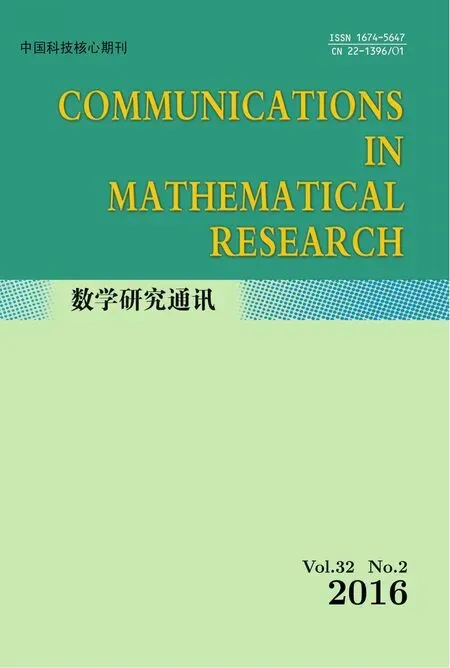On Integrable Conditions of Generalized Almost Complex Structures
YIN YAN-BINAND LIU LING
(1.School of Mathematics and Statistics,Henan University,Kaifeng,Henan,475004)
(2.School of Applied Science,Beijing Information Science and Technology University, Beijing,100192)
Communicated by Rong Xiao-chun
On Integrable Conditions of Generalized Almost Complex Structures
YIN YAN-BIN1AND LIU LING2
(1.School of Mathematics and Statistics,Henan University,Kaifeng,Henan,475004)
(2.School of Applied Science,Beijing Information Science and Technology University, Beijing,100192)
Communicated by Rong Xiao-chun
Generalized complex geometry is a new kind of geometrical structure which contains complex and symplectic geometry as its special cases.This paper gives the equivalence between the integrable conditions of a generalized almost complex structure in big bracket formalism and those in the general framework.
generalized almost complex geometry,big bracket,supermanifold
2010 MR subject classification:53D17,17B63
Document code:A
Article ID:1674-5647(2016)02-0111-06
1 Introduction
Generalized geometry was created by Hitchin[1]originally as a way of characterizing special geometry in low dimensions,and has been further developed by Hitchin’s students.
In[2],the integrable conditions under which a generalized almost complex structure becomes a generalized complex structure have been given in general way.The same question is discussed by using the big bracket formulism in supermanifold geometry by Kosmann-Schwarzbach and Rubtsov[3].
In this paper,we firstly recall some basic notions and facts about generalized complex structures,and then we devote to proving the equivalence between the integrable conditions of a generalized almost complex structure in different formalism.
2 Integrable Conditions of Generalized Almost Complex Structures
Assume that M is a real manifold with dimension 2n and set TM=TM ⊕T∗M.A generalized almost complex is an endomorphism N:TM−→TM such that
(1)N is symplectic,i.e.,〈Ne1,e2〉+〈e1,Ne2〉=0 for e1,e2∈Γ(TM);
(2)N is complex,i.e.,N2=−Id,
where〈·,·〉denotes the natural pairing given by〈X+ξ,Y+η〉=η(X)+ξ(Y)for X+ξ,Y+η∈Γ(TM).
Any generalized almost complex structure N may be presented by classical tensor fields as follows:

where π∈Γ(∧2TM),σ∈Ω2(M),and N is a(1,1)-tensor field over M,π♯:T∗M−→TM denotes a linear map defined by π♯(ξ)=iξπ=π(ξ,·)for ξ∈Ω1(M).Similarly,σ♯is a linear map defined by σ♯(X)=iXσ for X∈Γ(TM),N∗is the dual map of N.Clearly,N is symplectic if N is of the above form.
For any e=X+ξ∈Γ(TM),we have

This structure is described by the big bracket formulism in[3].The big bracket,denoted by{·,·},is an even graded bracket on the space O of functions on the cotangent bundle ΠT∗M,which is a supermanifold given by TM,more details are found in[4]–[5].The action of N on e∈Γ(TM)can be expressed as

that is,Ne={e,N}for any e∈Γ(TM).

By definition of the generalized almost complex structure,the endomorphism N=N+ π+σ of TM is a generalized almost complex structure if and only if the following equalities hold:
(a)N2+π♯σ♯=−Id;
(b)Nπ♯=π♯N∗;
(c)σ♯N=N∗σ♯.
The Dorfman torsion of a generalized almost complex N,denoted by τµN,is defined by τµN(e1,e2)=[Ne1,Ne2]µ−N([Ne1,e2]µ+[e1,Ne2]µ−N[e1,e2]µ),e1,e2∈Γ(TM), where the bracket[·,·]µis the canonical Courant bracket on M defined by [X+ξ,Y+η]µ={{X+ξ,µ},Y+η}=[X,Y]µ+LXη−iYdξ,X+ξ,Y+η∈Γ(TM). More caculations can be found in[3].If we define

the torsion of N may be expressed as

Proposition 2.1[3]In terms of big bracket,we have

and

Definition 2.1A generalized almost complex structure N is a generalized complex structure if τµN=0.
Theorem 2.1[3]A generalized complex structure is a generalized almost complex structure N satisfying

Comparing their degrees of two sides of the equality(2.1),we obtain the following theorem.
Theorem 2.2A generalized almost complex structure N=π+σ+N is a generalized complex structure if and only if
(I1)[N,N]µ+[π,σ]µ+[σ,π]µ=µ;
(I2)[N,π]µ+[π,N]µ=0;
(I3)[N,σ]µ+[σ,N]µ=0;
(I4)[π,π]µ=0.
Theorem 2.1 describes the compatible conditions under which a generalized almost complex structure becomes a generalized complex structure.Those compatible conditions are given in big bracket formalism.But it can be rewritten as the following theorem in a general way.
Theorem 2.3A generalized almost complex structure N=π+σ+N is a generalized complex structure if and only if for X,Y,Z∈Γ(TM),ξ,η∈Ω1(M),
(J1)τµN(X,Y)=π♯(iX∧Ydσ);
(J2)N∗[ξ,η]π=Lπ♯(ξ)N∗η−Lπ♯(η)N∗ξ−d(π(N∗ξ,η));
(J3)dσN(X,Y,Z)=dσ(NX,Y,Z)+dσ(X,NY,Z)+dσ(X,NY,Z)+dσ(X,Y,NZ), where σN(X,Y)=σ(NX,Y);
(J4)π♯[ξ,η]µ=[π♯(ξ),π♯(η)]µ.
Proof.Since N is complex,we have

Consider

It shows that{π,N}is a bivector from its bi-degree(2,0).Thus,πNis a bivector field and


Proof.Note that

Moreover,

and

Hence

which shows that

Furthermore,we can get

since N is complex.
Proof of Theorem 2.3We hope to prove that the integrable conditions in Theorem 2.2 are one-to-one equivalent corresponding to the integrable conditions in Theorem 2.3.
For the first condition,assume that

Then we have

Hence,τµN={dσ,π},and for X,Y∈Γ(TM),we have

Thus,

For the second condition,consider

Applying the second condition[π,N]µ+[N,π]µ=0 in Theorem 2.2,we have

and for any ξ,η∈Γ(T∗M),

Hence,

For the third condition,consider

Applying the third condition[N,σ]µ+[σ,N]µ=0,we obtain

Moreover,we have

Therefore,

The equivalence between the last compatible conditions in two theorems is obviously.
Remark 2.1Theorem 2.3 can be directly obtained in a general framework of Lie algebroids(see[2]).
[1]Hitchin N.Generalized calabi-yau manifolds.Q.J.Math.,2003,54(3):281–308.
[2]Crainic M.Generalized complex structures and Lie brackets.Bull.Braz.Math.Soc.,2011,42(4): 559–578.
[3]Kosmann-Schwarzbach Y,Rubtsov V.Compatible structures on Lie algebroids and Monge-Ampere operators.Acta Appl.Math.,2010,109(1):101–135.
[4]Yin Y B,He L G.Dirac strucures on protobialgebroids.Sci.China Ser.A,2006,49(10):1341–1352.
[5]Roytenberg D.On the Structure of Graded Symplectic Supermanifolds and Courant Algebroids. in:Quantization,Poisson Brackets and Beyond.Contemp.Math.vol.315.Providence,RI: Amer.Math.Soc.,2002:169–185.
10.13447/j.1674-5647.2016.02.03
date:Sept.7,2014.
The Excellent Talent Program(2012D005007000005)of Beijing.
E-mail address:yyb@henu.edu.cn(Yin Y B).
 Communications in Mathematical Research2016年2期
Communications in Mathematical Research2016年2期
- Communications in Mathematical Research的其它文章
- A Concentration Theorem of(R,p)-anders on Hadamard Manifolds
- Several Hermite-Hadamard Type Inequalities for Harmonically Convex Functions in the Second Sense with Applications
- Unstabilized Self-amalgamation of a Heegaard Splitting along Disks
- A Fixed Point Approach to the Fuzzy Stability of a Mixed Type Functional Equation
- A Note on General Third Geometric-arithmetic Index of Special Chemical Molecular Structures
- Fixed Point Theorems of the Iterated Function Systems
